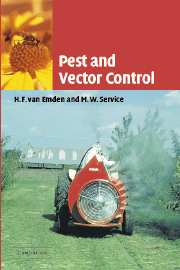Book contents
- Frontmatter
- Contents
- Preface
- 1 Man and insects
- 2 The causes of pest and vectored disease outbreaks
- 3 Insecticides and their formulation
- 4 Application of insecticides
- 5 Problems with insecticides
- 6 Environmental/cultural control
- 7 Biological control
- 8 Insect pathogens
- 9 Genetic control
- 10 Pheromones
- 11 Plant and host resistance
- 12 Other control measures and related topics
- 13 Pest and vector management
- Appendix of names of some chemicals and microbials used as pesticides
- References
- Index
2 - The causes of pest and vectored disease outbreaks
Published online by Cambridge University Press: 03 December 2009
- Frontmatter
- Contents
- Preface
- 1 Man and insects
- 2 The causes of pest and vectored disease outbreaks
- 3 Insecticides and their formulation
- 4 Application of insecticides
- 5 Problems with insecticides
- 6 Environmental/cultural control
- 7 Biological control
- 8 Insect pathogens
- 9 Genetic control
- 10 Pheromones
- 11 Plant and host resistance
- 12 Other control measures and related topics
- 13 Pest and vector management
- Appendix of names of some chemicals and microbials used as pesticides
- References
- Index
Summary
Introduction
As pointed out in Chapter 1, a commonly quoted statistic is that, without insect pests in the field and store, world food production could be increased by about a half. As this estimate represents the loss despite current control measures, it would clearly be catastrophic for mankind if control of insect pests were not attempted or should fail. The efficient control of certain disease vectors would save very many human lives, and then even more additional food would be needed to feed the hungry, even more rapidly expanding population. Thus more effective vector control would have the knock-on effect of creating a demand for even more effective pest control!
The pest problem
Obviously each insect individual has a fairly small food requirement. For example, a greenfly (aphid) is unlikely to extract more than about 0.5 cm3 of sap from a plant in its lifespan, and even a voracious caterpillar is likely to consume only 50 g of the fresh weight of its host plant.
Although some pests, such as those that spoil a whole apple with one small blemish or those that vector plant diseases, can cause damage even at low populations, the damage done by most crop pests results from the enormous numbers in which they occur. There may often be 25 million insects per hectare of soil and 25 000 in flight over a hectare, compared with a human density over the dry land of the earth of about 0.2 per hectare.
- Type
- Chapter
- Information
- Pest and Vector Control , pp. 31 - 51Publisher: Cambridge University PressPrint publication year: 2004



